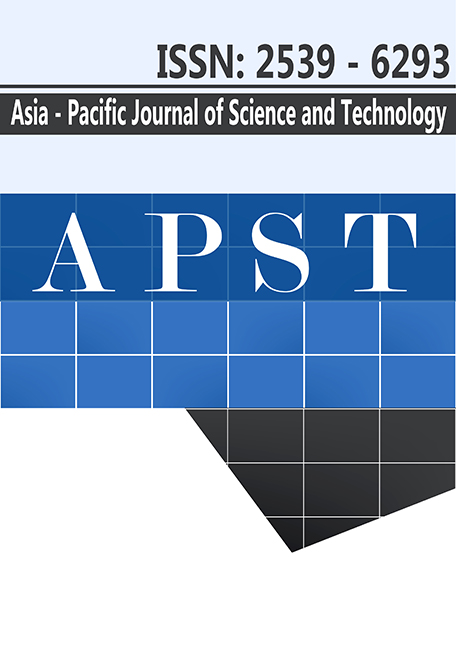Cassava leaf harvesting management and positive impact on growth and yields of Eri silkworm
Main Article Content
Abstract
Cassava is one of the major host plants for eri silkworm rearing, especially in Thailand. The representatives for extension and popular varieties, Kasetsart 50 (KU50) and Rayong 11, were used in field experiments to determine the effect of cassava leaf harvest management and rearing eri silkworm. Cassava leaves were harvested three times (in batches) with cassava aged 6, 8 and 10 months. Each time, 30% of the leaves were harvested per plant using two methods, harvesting every day and every other day. The experiments were conducted using a randomized complete block design (RCBD) comprising four treatments and three replicates with ten plants/replicate. It was found that the average number of Rayong 11 cassava leaves, harvested every other day (68,534.40 leaves/rai) was higher than KU50 (45,758.40 leaves/rai). Also for every day harvested, Rayong 11 (63,883.20 leaves/rai) were still in greater numbers than KU50 (52,195.20 leaves/rai). The harvested leaves were used as food material for rearing three batches of eri silkworm with leaf harvesting three times. The life cycle (egg–adult) of all batches fed with KU50 and Rayong 11 were similar (between 41–68 days). For survival of larval stages (1st–5th instar), larva (1st‑5th instar) and adults for the 1st and 2nd batches, Rayong 11 was higher but not significantly different than KU50. Whereas in the 3rd batch, KU50 showed a maximum survival percentage of the 1st–5th instar (91%) and no significant difference than when feeding with Rayong 11 (89.33%). For larva (1st–5th instar) – adult, KU50 still gave a higher survival rate (75%) and was significantly different (P<0.05) from Rayong 11 (60%). Considering the average cocoon and egg yields, in the 1st batch, all cocoon yields obtained from feeding with KU50 were the higher values. Only fresh cocoon weight, pupa weight, shell weight and total shell weight were significantly different (P<0.05) when compared to Rayong 11. For egg yields, Rayong 11 exhibited higher average yields than KU50, but these values were not significantly different. For the 2nd batch, all cocoon yields were similar irregardless of the cassava variety fed and they were not significantly different. However, feeding with KU50 yielded higher fresh cocoon weights (2.0563 g), pupa weights (1.7650 g) and fresh cocoon weights/10,000 larvae (18.85 kg). Feeding with Rayong 11 gave higher yields based on shell weight (0.2830 g), %shell (14.02%) and total shell weight (26.04 g). Moreover, Rayong 11 fed to eri silkworms showed higher and statistically significant (P<0.05) differences in the total number of eggs and hatchability than feeding with KU50. In the 3rd batch, yields from KU50 were higher for fresh cocoon weight (2.1980 g), pupa weight (1.9156 g) and fresh cocoon weight/10,000 larvae (20 kg). When feeding with Rayong 11 the highest yields were for shell weight (0.2870 g), %shell (13.13%) and total shell weight (25.63 g). Feeding with KU50 gave significantly higher (P<0.05) yields for the total number of eggs and total hatchability compared to feeding with Rayong 11. The results of this research revealed that the method, frequency, timing and variety for cassava leaf harvesting management is very useful to improve the benefits for cassava plantations and eri silkworm rearing as a whole.
Article Details
References
[2] Sirimungkararat, S., Thai eri silkworm toward international. Leaflet. N.D.
[3] Wongtong, S., Areekul, P., Onlamoon, A., Tragoolgarn, S., 1980. Research on wild silkworm culture in the highland of northern Thailand. Final report, Highland Agriculture Project, June 1976–June 1980. Kasetsart University. Bangkok.
[4] Suryanarayana, N., Singh, K.C., 2005. Principles of eri culture. Agrawal Ramchi: Press.
[5] Sirimungkararat, S., 2014. Eri silkworm and its exploitation. Khon Kaen: Klung Nana Publishing Co. (In Thai)
[6] Sangtamat, T., Sirimungkararat, S., Saksirirat, W., Wongsorn, D., 2007. Effect of some main–and alternate food plants on growth of eri silkworm (Samia ricini D.). Kaen Kaset. 35, 196-202. (In Thai)
[7] Center of agricultural information, Office of Agricultural Economy., 2015. Industrial cassava: Planting area, harvesting area, yield and yield per rai for year 2013–2016. [WWW Document] URL URL: https://www.oae.go.th/download/prcai/DryCrop/cassava.pdf. (accessed 1. 10. 15). (In Thai)
[8] Sorawat, W., 2011. Guidline for cassava yield increasing of Khon Kaen province. Khon Kaen: Khon Kaen Cooperative Ltd. (In Thai)
[9] Department of Agriculture (DOA)., 2013. Suitable cassava varieties for certain areas. [WWW Document] URL: https://at.doa.go.th/cassava/variety_cas.php. (accessed 1. 10. 15). (In Thai)
[10] Sirimungkararat, S., Phongam, J., Pattanasetthanon, W., Bunchan, S., Apinakponge, K., 2000. Increasing yield of cassava and eri silkworm by managing and leaf harvesting. Agriculture Annual Conference for Year 2000. January 24 – 25th 2000. Fac. of Agriculture. Khon Kaen University. Khon Kaen. (In Thai)
[11] Hue, K.T., Van, D.T.T., Ledin, I., Wredle, E., Spörndly, E., 2012. Effect of harvesting frequency, variety and leaf maturity on nutrient composition, hydrogen cyanide content and cassava foliage yield. Asian–Australasian Journal of Animal Sciences 25, 1691-1700.
[12] Boonpeng, O., Mealybug, A serious pest of cassava. N.D. [WWW Document] URL https://www.tapiocathai.org/N.html. (accessed 12. 5. 14). (In Thai)
[13] Lakshmi, R., 2012. Potentiality of eri culture for poverty alleviation in dry land areas of Andhra Pradesh. Indian Silk 2, 20-24.
[14] Attathom, T., Kanhasut, W., Areekul, S., 1992. Eri silkworm rearing using different food plant. The 30th Annual Conference Report of Kasetsart University Conference. Plant Science Section; 1992 Jan 29th – Feb 1st 1992, Thailand. Bangkok. (In Thai)
[15] Phengvichith, V., Ledin, S., Horne, P., Ledin, I., 2006. Effect of different fertilizers and harvest frequencies on foliage and tuber yield and chemical composition of foliage from two cassava (Manihot esculenta, Crantz) varieties. Tropical and Subtropical Agroecosystems 6, 177-187.


